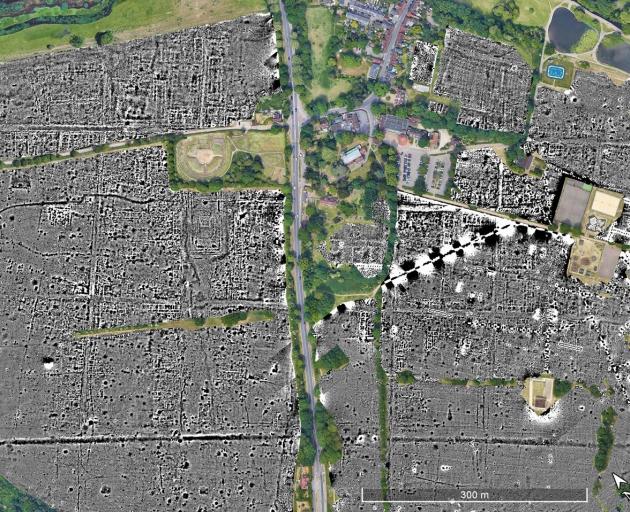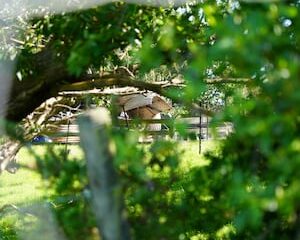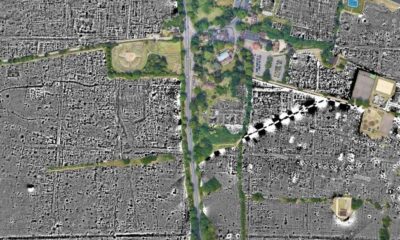Science
New Techniques Reveal Ancient Secrets of Verulamium

A recent geophysical survey at Verulamium is uncovering remarkable details about the ancient Roman city. The survey employs advanced technology to map the city’s layout, revealing streets, houses, kilns, and walls that have remained hidden for centuries. This initiative is part of ongoing archaeological efforts to understand the city that once thrived behind a circuit of stone walls.
In a surprising twist, the survey has also confirmed the existence of an early Roman defensive ditch, initially mapped in a previous project involving the use of a proton magnetometer. This device, considered groundbreaking at the time, helped identify disturbances in the ground, leading to the discovery of the ditch, which was likely constructed hastily in anticipation of an attack by the forces of Queen Boudicca.
Advancements in Archaeological Techniques
The new geophysical survey employs techniques that significantly extend the reach of previous methods. As researchers delve into the city’s interior, they are able to visualize the intricate grid pattern of streets that divided the city into distinct sections. Each section showcases a range of residential structures, complete with hypocausts, bath complexes, and exquisite mosaic floors.
Among the most notable features identified is the forum, which served as a central hub of activity, flanked by a theatre and a large temple. The survey’s results provide a clearer understanding of the urban design and organization of Verulamium. One particularly striking element is the early enclosure ditch, now visible as a dark straight line on the survey map, turning at a right angle on its western edge.
Interestingly, the research team chose not to conduct readings beneath the St Alban’s first XI cricket pitch, mindful of potential disruption to the sporting venue. This decision reflects the balance between preserving contemporary uses of the land and uncovering its ancient past.
Unearthing Hidden Treasures
The research has also identified a sinuous dark line that represents an aqueduct leading to the theatre, which once brought water to the heart of the city. During previous excavations, a stunning mosaic floor featuring a lion was uncovered, hinting at the artistic and cultural richness that may still be buried beneath the surface.
As technology continues to advance, the potential for further discoveries at Verulamium grows. The current survey not only provides insights into the city’s infrastructure but also opens the door to uncovering more hidden treasures that lie deep underground. Each finding adds to the complex narrative of Verulamium, revealing a city that once played a significant role in Roman Britain.
As researchers explore these ancient remnants, they continue to piece together the vibrant history of Verulamium, ensuring that its secrets are not lost to time but instead celebrated and understood by future generations.
-

 World2 weeks ago
World2 weeks agoPrivate Funeral Held for Dean Field and His Three Children
-

 Top Stories2 weeks ago
Top Stories2 weeks agoFuneral Planned for Field Siblings After Tragic House Fire
-

 Sports3 months ago
Sports3 months agoNetball New Zealand Stands Down Dame Noeline Taurua for Series
-

 Entertainment3 months ago
Entertainment3 months agoTributes Pour In for Lachlan Rofe, Reality Star, Dead at 47
-

 Entertainment2 months ago
Entertainment2 months agoNew ‘Maverick’ Chaser Joins Beat the Chasers Season Finale
-

 Sports3 months ago
Sports3 months agoSilver Ferns Legend Laura Langman Criticizes Team’s Attitude
-

 Sports1 month ago
Sports1 month agoEli Katoa Rushed to Hospital After Sideline Incident During Match
-

 World3 weeks ago
World3 weeks agoInvestigation Underway in Tragic Sanson House Fire Involving Family
-

 Politics2 months ago
Politics2 months agoNetball NZ Calls for Respect Amid Dame Taurua’s Standoff
-

 Top Stories2 weeks ago
Top Stories2 weeks agoShock and Grief Follow Tragic Family Deaths in New Zealand
-

 Entertainment3 months ago
Entertainment3 months agoKhloe Kardashian Embraces Innovative Stem Cell Therapy in Mexico
-

 World4 months ago
World4 months agoPolice Arrest Multiple Individuals During Funeral for Zain Taikato-Fox





















